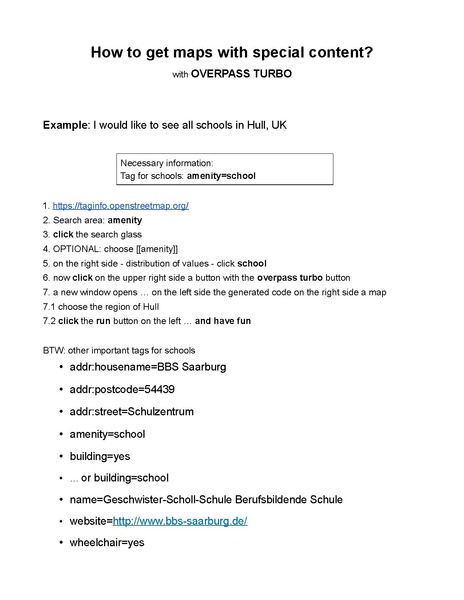
It runs any kind of Overpass API query and shows the results on an. Note that the output format will not be 100% compatible with the normal OSM XML format in that case. Overpass turbo () is a web based data mining tool for OpenStreetMap. Or try out meta instead of out body to also get meta data (version information, last changed date, etc.).ĭepending on your changes, you might find an empty map and only some data in the "Data" tab in overpass turbo.īTW: Instead of out body > out skel qt you can also use out geom when using overpass turbo. comment out out skel qt run the query again and check the results in overpass turbo. To get a better understanding of those different statements, you could e.g. qt is a sorting option (by quadtile), which is also meant as a performance optimization. The idea here is to just return the geometry information, but leave out any tags.

To reduce the amount of unwanted by-catch, we use out skel instead of out body. Out skel qt - in this last statement, we will now print out the results of the previous > (recurse down) statement. For many use cases the wizard creates useful queries out of the box already. This way you can easily get started with Overpass API without having to deal with all the details. > : This statement is called recurse down and resolves ways to its nodes, and relations to its ways and nodes. overpass turbo wizard uses a template based approach to create an Overpass QL query. This first step will print all of the node details, the ways (without nodes(!)) and relations (without details about ways and nodes(!)) you requested. Hot wheels ai car and controller turbo diesel car & controller: Hot wheels ai starter set arkham asylum Sale off 75 > hot wheels ai starter set arkham asylum chase edition track set discover the latest trends when you shop mens & womens fashion online. These are also tags for all elements and the roles for relation members. Out body : this prints all information necessary to use the data. ( ) is a union block statement, which simply combines the result of the individual queries, in this case the set of all nodes, ways and relations with shop=bicycle in the current bbox. There are many other ways to control the query creation, just take a look at different options on said wiki page. To change this behavior and create a query for a certain type, you can use the type: syntax as outlined in the wiki. Now, regarding your questions: by default, those queries include both nodes, ways and relations. This is too easy to overlook and thus a frequent source of mistakes.Overpass turbo wizard uses a template based approach to create an Overpass QL query. That are in the set all and that have a tag with key atm and value yes.Īlthough this would be technically possible,īut we then would need to divert the result of each line individually. That are in the set all and that have a tag with key amenity and value atm. Thus, in line 3 are found exactly the objects This filter restricts the result to the content of the set all. This set is used twice in the union block:Ī filter for a set. It has a C style syntax: The whole query.



In this query statement all objects from the bounding box are cached in the set all. Overpass QL is the second query language for the Overpass API and was designed as an alternative to Overpass XML. The example has a small bounding box: nwr()->.all ( nwr.all nwr.all ) out center Ī query statement in line 1 is prepended to the union statement now in lines 2 to 5. The tag amenity with value atm indicates such devices. We fix as a default example for the moment Tag and area, tag and two areas as well as two tags Several such examples for intersections have already been introduced: You could try executing this query from umap. Such that only objects are found that fulfill all of the conditions. Indeed, Overpass Turbo is a tool to show data, it's not really meant to explore data in an interactive way like you want. It takes some time getting used to, but luckily there is Overpass Turboby Martin Raiferwhich comes in handy to interactively evaluate our queries directly in the browser. We start with combining two or more filters The Overpass API uses a custom query languageto define the queries.


 0 kommentar(er)
0 kommentar(er)
